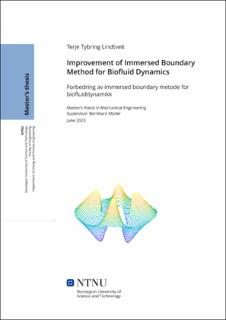| dc.contributor.advisor | Müller, Bernhard | |
| dc.contributor.author | Lindtveit, Terje Tybring | |
| dc.date.accessioned | 2023-10-03T17:22:52Z | |
| dc.date.available | 2023-10-03T17:22:52Z | |
| dc.date.issued | 2023 | |
| dc.identifier | no.ntnu:inspera:142434234:35324915 | |
| dc.identifier.uri | https://hdl.handle.net/11250/3093919 | |
| dc.description.abstract | I denne masteroppgaven presenteres en høyordens skarp grenses "immersed boundary" metode utviklet for varmeligningen. Metoden er basert på en andre ordens "finite difference" løser hvor geometriene er representert ved hjelp av en spøkelsespunkt metode. I denne prosedyren bestemmes spøkelsespunktene ved hjelp av en minste kvadraters metode der randbetingelsen på geometrien blir tilnærmet med et høyordens polynom. Den viktigste bidraget i denne oppgaven er utviklingen av en metode for å oppnå høyordens løsninger ved bruk av Richardson-ekstrapolasjon, som dermed unngår bruk av store spøkelsespunkt stensiler. Metodene blir verifisert for stasjonære varmeledningsproblemer med Dirichlet- og Neumann-randbetingelser. Videre utvides verifiseringen til tidsavhengige varmeledningstilfeller ved å simulere varmeledning i et tverrsnitt av en uendelig sylinder med konstant overflatetemperatur. Implementeringen av metoden viser stor grad av nøyaktighet for randbetingelsene og viser potensiale for anvendelse innenfor relevante områder for ingeniørfag og biofluid-dynamikk. Fremtidig potensiale for metoden blir diskutert, og mulige forbedringer er drøftet. | |
| dc.description.abstract | In this thesis, a high-order sharp interface immersed boundary method for solving the heat conduction equation is presented. The approach is based on a second-order finite difference scheme with the immersed boundaries resolved through a sharp interface ghost point method. In this approach, the ghost point values are determined by a Weighted Least Squares technique in which the boundary condition is imposed at the immersed boundary with a high-order approximating polynomial. The main contribution of this thesis is the development of a method for achieving higher-order solutions through the use of Richardson extrapolation with a grid-doubling approach, thus avoiding the use of large ghost point stencils. The methods are verified for steady-state heat conduction problems with Dirichlet and Neumann boundary conditions. Furthermore, the verification is extended to time-dependent heat conduction cases by simulation of heat conduction in a cross-section of an infinite cylinder with constant surface temperature. The implementation of the method is shown to accurately resolve the boundary conditions and shows potential for application in areas of practical interest within the domain of engineering and biofluid dynamics. The future potential of the method and possible improvements are discussed. | |
| dc.language | eng | |
| dc.publisher | NTNU | |
| dc.title | Improvement of Immersed Boundary Method for Biofluid Dynamics | |
| dc.type | Master thesis | |
